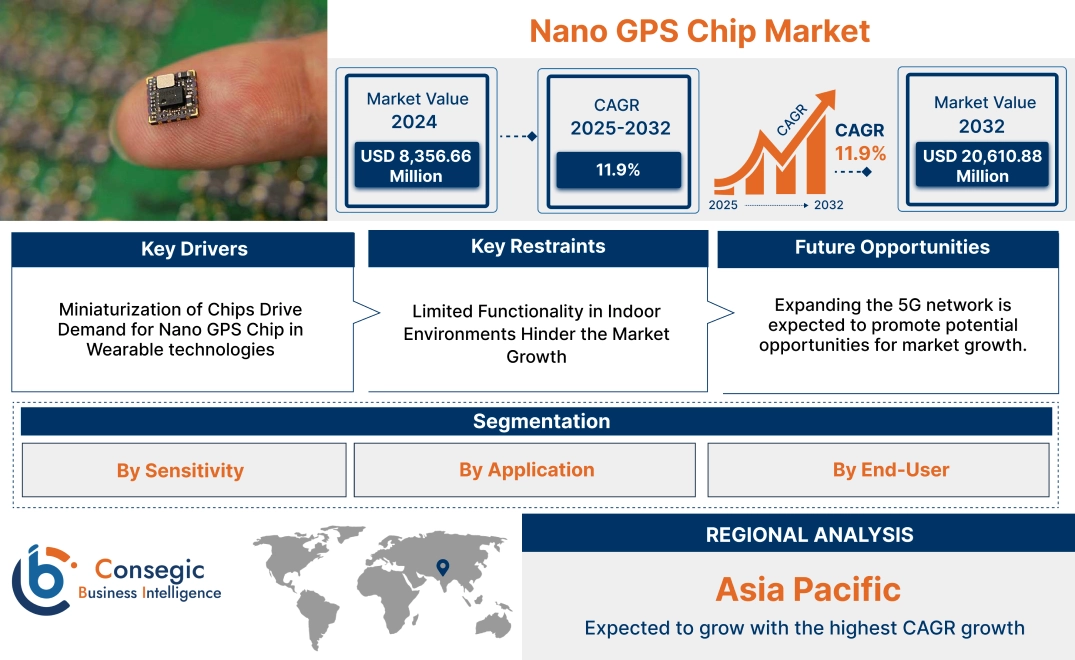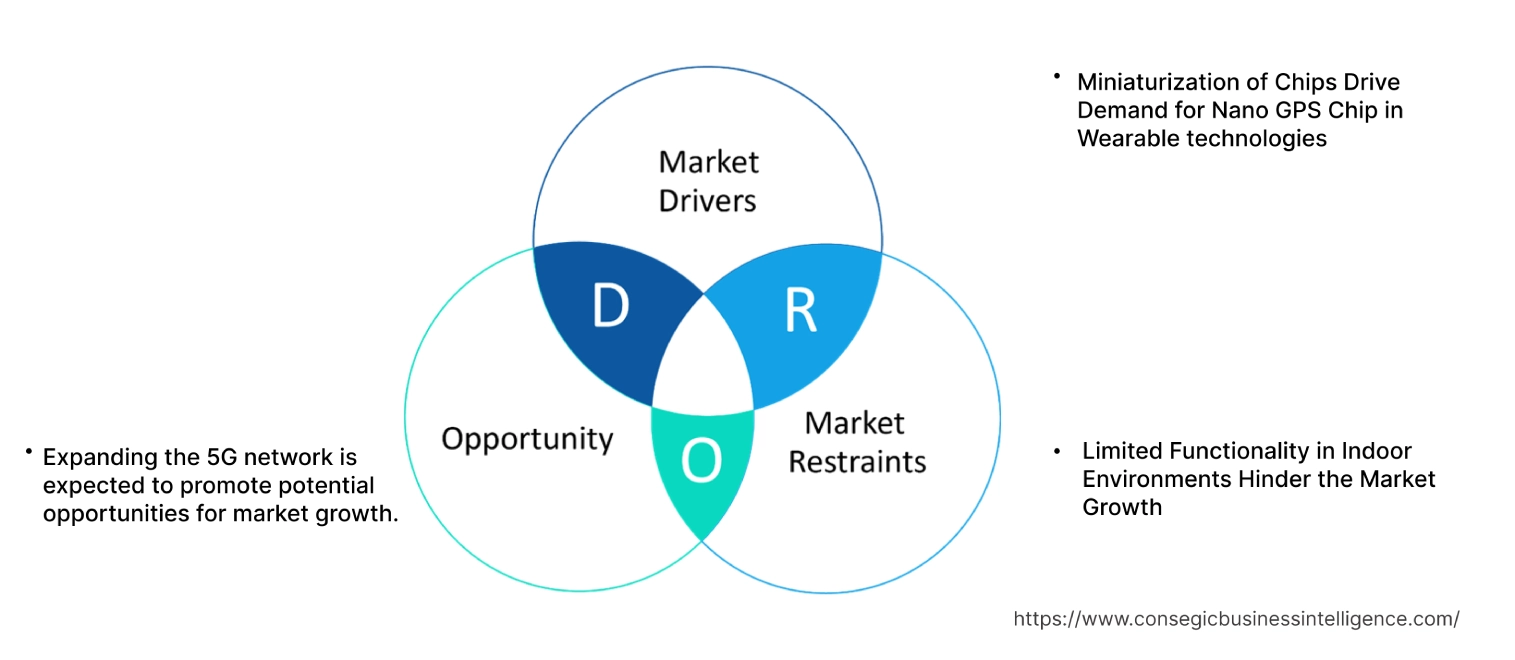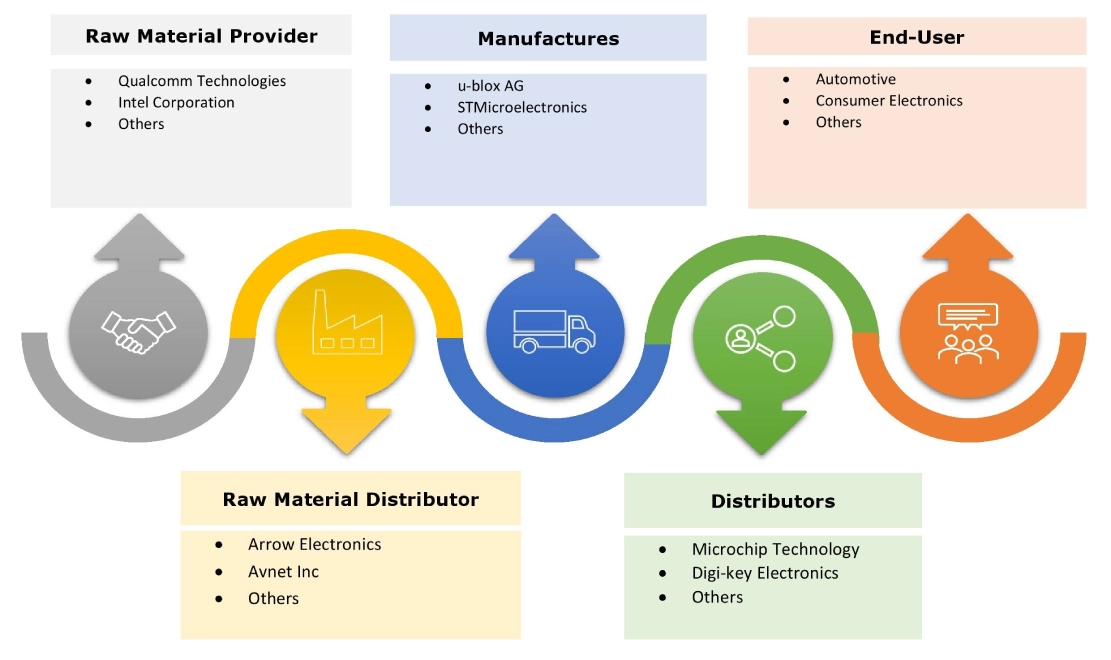Nano GPS Chip Market Size:
Nano GPS Chip Market is estimated to reach over USD 20,610.88 Million by 2032 from a value of USD 8,356.66 Million in 2024 and is projected to grow by USD 9,209.54 Million in 2025, growing at a CAGR of 11.9% from 2025 to 2032.
Nano GPS Chip Market Scope & Overview:
A nano GPS chip is a compact chip integrated with advanced global positioning system technology in a miniature form factor. The primary role of nano chips is to enhance navigation capabilities driving their application in various end-use industries including automotive, consumer electronics, agriculture, and more. Moreover, the advantages include a small form factor, low power consumption, high sensitivity, and others driving the nano GPS chip market demand due to high accuracy in harsh conditions. Further, the nano chips are integrated into various wearable devices for mapping and tracking various factors such as asset tracking which in turn drives the nano GPS chip market growth.
How AI is Impacting the Nano GPS Chip Market?
AI is profoundly impacting the nano GPS chip market by enhancing their capabilities and driving demand across various applications. AI algorithms integrated into these tiny chips enable more precise and reliable location tracking, especially in challenging environments where traditional GPS struggles with signal loss or interference. They achieve this by intelligently processing noisy signals, fusing data from multiple sensors (like IMUs), and even predicting positioning during GPS outages. This increased accuracy and robustness, coupled with optimized power consumption through AI, makes nano GPS chips ideal for the burgeoning IoT, wearable devices, autonomous vehicles, and smart manufacturing sectors, thereby significantly expanding the market.
Nano GPS Chip Market Dynamics - (DRO) :
Key Drivers:
Miniaturization of Chips Drive Demand for Nano GPS Chip in Wearable technologies
The rapidly growing wearable technologies such as smartwatches, fitness trackers, VR headsets, and others drive the demand for compact and efficient chips. Moreover, the advantages including low power consumption, compact form factor, high accuracy, and others fuel the adoption of wearable electronics due to the smaller size of fitness trackers and smartwatches. Further, the compact size and slim design of various wearable electronics drive the demand for miniaturization of chips which in turn boosts the nano GPS chip market growth.
- For instance, in November 2024, u-blox launched UBX-M10150-CC GNSS, which featuring chip measuring 2.39 x 2.39 x 0.55 mm, highly efficient performance and upgradable firmware. The features drive the adoption of compact and slimmer wearable technologies.
Thus, the rapidly growing wearable technologies and miniaturization of chips drive the adoption of wearable technology which in turn fuels the nano GPS chip market size.
Key Restraints:
Limited Functionality in Indoor Environments Hinder the Market Growth
The nano GPS chips are designed especially for outdoor utilization and the performance and accuracy decline when used in indoor environments. Additionally, signals struggle to penetrate buildings and other structures which leads to poor signal or no signal hindering the nano GPS chip market expansion. Moreover, the limitations pose a hindrance to drive adoption in large shopping malls, warehouses, or underground parking garages.
Therefore, the limitations associated with the functionality in an indoor environment are restraining the nano GPS chip market expansion.
Future Opportunities :
Expanding the 5G network is expected to promote potential opportunities for market growth.
- For instance, in November 2024, u-blox launched SARA-R10001DE, an LTE Cat 1bis module, which features embedded SIM to support multi-IMSI technology, and eUICC driving its adoption in IoT applications. The chip is designed to improve the robustness, reliability, and resilience of IoT devices.
Hence, the integration of 5G with GPS chips is anticipated to increase the utilization of smart city infrastructure, autonomous vehicles, and others which in turn promote market growth during the forecast period.
Nano GPS Chip Market Segmental Analysis :
By Sensitivity:
Based on the sensitivity, the market is bifurcated into below −165 dBm and -165 dBm and above.
Trends in the Sensitivity:
- The trends towards an increasing number of entry-level smartphones and wearables are driving the adoption of below -165 dBm sensitivity.
- The integration of GPS chips with -165 dBm and above sensitivity is driving the adoption in autonomous vehicles, drone operations, and others which in turn fuels the nano GPS chip market trends.
The below −165 dBm accounted for the largest revenue share in the year 2024.
- The effectiveness of a GPS signal is presented in decibels and the GPS receiver collects data from every satellite to determine the distance and location.
- Further, the cost-effectiveness drives the adoption of GPS chips with below -165 dBm sensitivity. Furthermore, the rising utilization in transportation, consumer electronics, and other industries drives below -165 dBm sensitivity.
- For instance, Semtech offers a GPS receiver module featuring High sensitivity of up to -143 dBm tracking, position accuracy, and other driving its adoption in automotive, fleet management/asset tracking, palmtop, laptop, PDA, location-based services enabled devices, and handheld receivers.
- Thus, as per the market analysis, cost-effectiveness of below -165 dBm sensitivity, in turn, drives the nano GPS chip market share.
The -165 dBm and above is anticipated to register the fastest CAGR during the forecast period.
- The ability to provide higher accuracy and reliability in harsh conditions or indoor environments is driving the need for a -165 dBm sensitivity GPS chip.
- Further, the greater the negative value, the less strong the transmission in turn driving −165 dBm and above sensitivity.
- Furthermore, the rising need for highly sensitive chips for driving adoption in autonomous vehicles, drone operations, and other applications requiring precise location capability is driving the -165 dBm and above sensitivity.
- Therefore, as per the market analysis, the rising need for highly sensitive chips as well as the ability to provide higher accuracy and reliability is anticipated to boost the nano GPS chip market share during the forecast period.
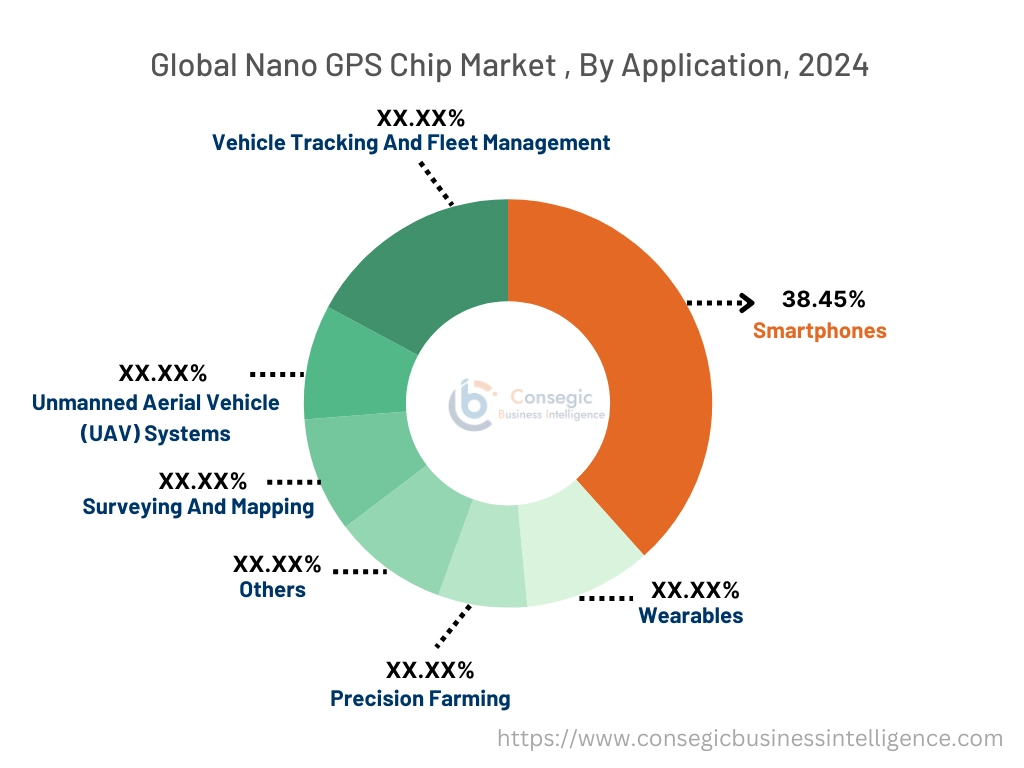
By Application:
Based on the application, the market is segmented into surveying and mapping, unmanned aerial vehicle (UAV) systems, vehicle tracking and fleet management, smartphones, wearables, precision farming, and others.
Trends in the Application:
- The trend towards increasing the need for accurate geospatial data in infrastructure projects is driving the adoption of GPS chips in surveying and mapping applications.
- The trend towards enhancing agriculture efficiency and reducing overall operational cost is driving the adoption of GPS chips for precision in planting, harvesting, and irrigation.
Smartphones accounted for the largest revenue share of 38.45% in the year 2024.
- Smartphones are embedded with GPS chips to provide services such as navigation, tracking, and other location-based services.
- Moreover, the rising adoption and sale of smartphones are driving the demand for the nano GPS chip market.
- Further, smartphones are used to track fitness as well as integrate with emerging technologies such as AR/VR which increases the need for nano GPS chips.
- For instance, in October 2024, Apple announced FY2024 Q4 revenue of USD 94.9 billion which is up by 6 percent year over year. Additionally, the Apple iPhone sales reached USD 201,183 which in turn drives the adoption of GPS chips utilized in the smartphones.
- Thus, according to the nano GPS chip market analysis, the rising adoption of smartphones is driving the nano GPS chip market.
Vehicle tracking and fleet management are anticipated to register the fastest CAGR during the forecast period.
- The vehicle tracking and fleet management embedded with GPS chips helps in real-time monitoring, analyzing fuel consumption, reduce risks and costs related to vehicle management among others.
- Further, the growing logistics and e-commerce business is driving the adoption of GPS chips in vehicle tracking and fleet management applications.
- Furthermore, the stringent rules and regulations associated with commercial vehicles across the globe are propelling the nano GPS chip market demand.
- For instance, in Jul 2022, Group Management Services launched a fleet management system. The system offers a GPS fleet tracking system for gaining better control and reducing unlawful driving with geofencing among others.
- Therefore, as per the analysis, the growing logistics and e-commerce business is anticipated to boost the market during the forecast period.
By End-User:
Based on the end-user, the market is segmented into automotive, consumer electronics, logistics & transportation, agriculture, healthcare, aerospace & defense, and others.
Trends in the End-User:
- The expanding e-commerce and supply chain operations are fueling the need for vehicle tracking which in turn drives the nano GPS chip market.
- The trend towards smart agriculture and precise farming is propelling the adoption of nano GPS chips for crop monitoring and yield monitoring among others.
Consumer Electronics sector accounted for the largest revenue share in the year 2024.
- The consumer electronics sector includes products such as smartphones, smartwatches, fitness trackers, and AR/VR technology among others utilizing GPS chips for providing navigation and location tracking capabilities.
- Further, smartphones and smartwatches are embedded with GPS chips and the rising adoption of smartphones and smartwatches propels the market progress.
- Furthermore, the advancing 5G network is paving the way for improving accuracy and connectivity which in turn fuels the GPS chip precision and tracking capabilities.
- For instance, in October 2024, according to IBEF India, the smartphone market in India shipped over 152 million units, and smartwatch shipments grew 50% YoY in FY23. Hence, the increasing manufacturing of smartwatches and smartphones drives the nano GPS chip industry.
- Thus, according to the nano GPS chip market analysis, the rising adoption of smartphones and smartwatches as well as the growing consumer electronics sector is driving the nano GPS chip market trends.
Automotive Sector is anticipated to register the fastest CAGR during the forecast period.
- The emerging technologies including Advanced Driver-Assistance Systems (ADAS) and self-driving cars require GPS chips for improving navigation and tracking which in turn enhances the safety of passengers.
- Further, the rising adoption of electric vehicles is propelling the need for GPS chips for navigating charging stations, and vehicle tracking among others in turn driving the market.
- Furthermore, the GPS chips help in traffic management which drives the smart city initiative.
- For instance, in May 2022, Hyundai partnered with Motional to develop the IONIQ 5-based robotaxi. The IONIQ is equipped with advanced autonomous driving technology and the car is an SAE Level 4 autonomous vehicle that safely operates without a driver.
- Therefore, the rising adoption of electric vehicles requiring advanced driver-assistance systems (ADAS) and self-driving cars requiring GPS chips is anticipated to boost the market during the forecast period.
Regional Analysis:
The regions covered are North America, Europe, Asia Pacific, the Middle East and Africa, and Latin America.
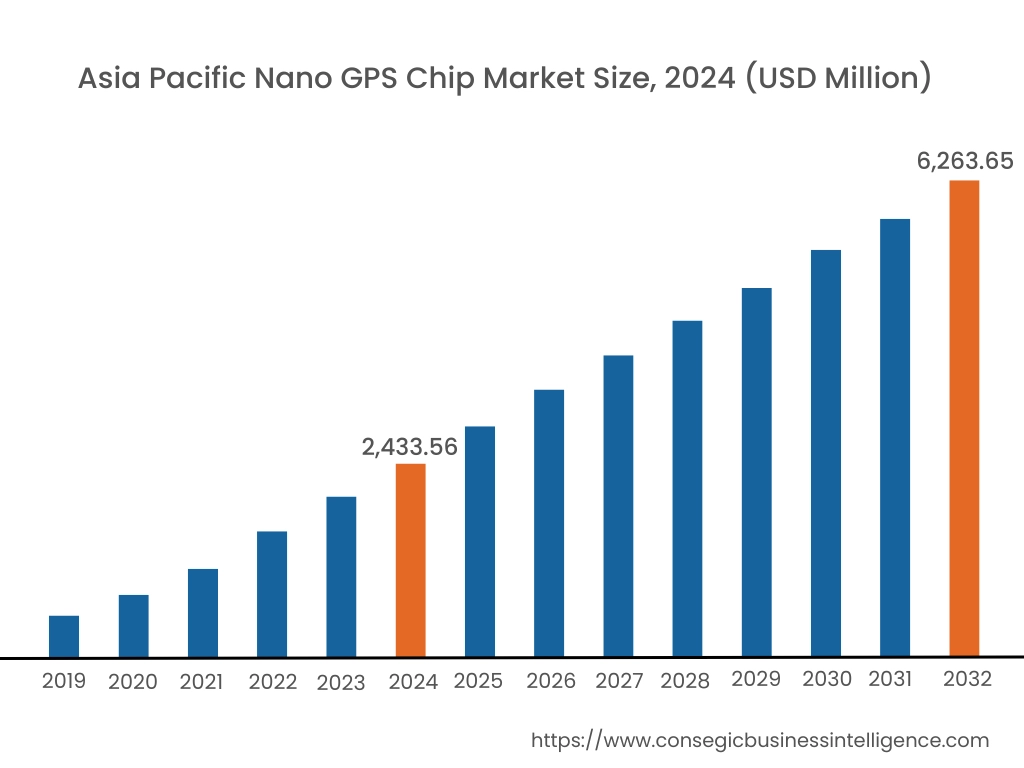
Asia Pacific region was valued at USD 2,433.56 Million in 2024. Moreover, it is projected to grow by USD 2,691.66 Million in 2025 and reach over USD 6,263.65 Million by 2032. Out of this, China accounted for the maximum revenue share of 28.8%. The market growth for GPS chips is mainly driven by their deployment in consumer electronics and other industries. Furthermore, factors including the growing adoption of smartphones and smartwatches among others are driving the market development. Furthermore, the growing adoption of GPS chips for precision farming drives the market growth in the Asia Pacific region during the forecast period.
- For instance, according to IBEF India, agricultural as well as processed food products exports reached USD 4.34 billion in 2024-25. Additionally, total foodgrain production in India is estimated at 148.5 million tonnes which is propelled by the growing adoption of cutting-edge techniques including geographic information systems (GIS), drones, and remote sensing technologies among others.

North America is estimated to reach over USD 6,294.56 Million by 2032 from a value of USD 2,507.89 Million in 2024 and is projected to grow by USD 2,767.90 Million in 2025. The North American region's growing automotive and aerospace industry offers lucrative growth prospects for the market. Additionally, the rising adoption of advanced technologies such as autonomous vehicles and drones among others drives the nano GPS chip market size.
- For instance, according to Hyundai, in the US the company sold 251 thousand units in FY24 Q3 which was 225 thousand units in FY23 Q3. Hence, the growing adoption of automotive vehicles is fueling the need for nano GPS chips.
The regional trends analysis depicts that the increasing adoption of autonomous and electric vehicles in Europe is driving the market demand. Additionally, the primary factor driving the market in the Middle East and African region is the growing oil and gas sector which in turn propels government initiative and funding towards advanced transportation systems for tracking and fleet management. Further, the rising adoption of smartphones and smartwatches as well as the growing logistics and transportation sector is paving the way for the progress of the market in the Latin America region.
Top Key Players and Market Share Insights:
The global nano GPS chip market is highly competitive with major players providing GPS chips to the national and international markets. Key players are adopting several strategies in research and development (R&D), product innovation, and end-user launches to hold a strong position in the nano GPS chip industry. Key players in the nano GPS chip market include-
- Unicore Communications, (China)
- Skywonder GPS (China)
- Shenzhen Esino Technology Ltd (China)
- Shenzhen Zhonghe Electronics Co., Ltd (China)
- Analog Devices Inc. (USA)
- Broadcom (USA)
- OriginGPS Ltd. (Israel)
- LOCOSYS Technology Inc. (Taiwan)
- u-blox AG (Switzerland)
- STMicroelectronics (USA)
Recent Industry Developments :
Partnerships & Collaborations
- In September 2024, u-blox partnered with Topcon Positioning Systems to offer comprehensive GNSS positioning services. Additionally, the partnership aims to provide high-accuracy GNSS positioning services with increased accessibility, reliability, and affordability for the global market.
- In December 2023, Qualcomm Technologies, Inc., collaborated with the Indian Space Research Organisation (ISRO), to deliver superior location-based services and enhance the geolocation capabilities and overall robustness of mobile, automotive, and the Internet of Things (IoT) solutions in the region.
Nano GPS Chip Market Report Insights :
| Report Attributes | Report Details |
| Study Timeline | 2019-2032 |
| Market Size in 2032 | USD 20,610.88 Million |
| CAGR (2025-2032) | 11.9% |
| By Sensitivity |
|
| By Application |
|
| By End-User |
|
| By Region |
|
| Key Players |
|
| North America | U.S. Canada Mexico |
| Europe | U.K. Germany France Spain Italy Russia Benelux Rest of Europe |
| APAC | China South Korea Japan India Australia ASEAN Rest of Asia-Pacific |
| Middle East and Africa | GCC Turkey South Africa Rest of MEA |
| LATAM | Brazil Argentina Chile Rest of LATAM |
| Report Coverage |
|
Key Questions Answered in the Report
How big is the Nano GPS Chip market? +
The Nano GPS Chip Market is estimated to reach over USD 20,610.88 Million by 2032 from a value of USD 8,356.66 Million in 2024 and is projected to grow by USD 9,209.54 Million in 2025, growing at a CAGR of 11.9% from 2025 to 2032.
What specific segmentation details are covered in the nano GPS chip report? +
The nano GPS chip report includes specific segmentation details for sensitivity, application, end-user, and regions.
Which is the fastest segment anticipated to impact the market growth? +
In the nano GPS chip market, vehicle tracking and fleet management is the fastest-growing segment during the forecast period due to growing logistics and e-commerce business as well as stringent rules and regulations associated with commercial vehicles across the globe.
How big is the Nano GPS Chip market? +
The Nano GPS Chip Market is estimated to reach over USD 20,610.88 Million by 2032 from a value of USD 8,356.66 Million in 2024 and is projected to grow by USD 9,209.54 Million in 2025, growing at a CAGR of 11.9% from 2025 to 2032.
What specific segmentation details are covered in the nano GPS chip report? +
The nano GPS chip report includes specific segmentation details for sensitivity, application, end-user, and regions.
Which is the fastest segment anticipated to impact the market growth? +
In the nano GPS chip market, vehicle tracking and fleet management is the fastest-growing segment during the forecast period due to growing logistics and e-commerce business as well as stringent rules and regulations associated with commercial vehicles across the globe.
